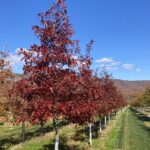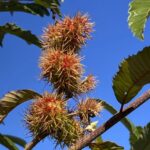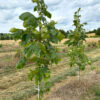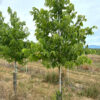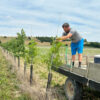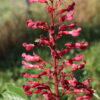As we finish out 2022, we turn to the common hackberry (Celtis occidentalis) as our featured native for the month. Celtis is a genus of around seventy species of deciduous trees distributed through the temperate regions of the Northern Hemisphere. For many years, the hackberries were considered sisters to the elms (Ulmus), but more recent genetic research has shown the genus to be quite closely related to hemp (Cannabis) and brewers hops (Humulus) and thus is now classified as the largest genus in the hemp family Cannabaceæ. The common name is believed to derive from the Scots ‘hagberry’, a vernacular for marsh berry.
[Article continues below photos.]
The common hackberry has a native range from the Dakotas south to Oklahoma and north Texas and eastward to North Carolina and New York. As its range would imply, this is a tree highly adapted to varying rainfall, from the semi-arid High Plains to the moisture-rich Southeast. Celtis occidentalis is a medium-sized tree, typically 12-20 meters (40-60 ft) in height; occasionally reaching 35m (120 ft) under ideal conditions. In the east, it is often found on rocky slopes, but is more common in stream valleys in the western reaches of its range. Despite its relatively modest size and adaptability, it is still seldom used in the landscape outside of the occasional employment as a street tress in some midwestern cities. A medium-fast grower, the mature tree tends to form an oval or vase-like crown with slightly drooping branches. The medium-green leaves are spear-shaped, generally 5-10 cm (2-4”) long with numerous small teeth. The autumn color is yellow or occasionally a reddish-purple. The bark is an interesting feature; light brown to sliver-grey with numerous corky ridges and warts. The inconspicuous green flowers emerge after the leaves; the edible fruit is a small (< 1cm / ⅓”) drupe with a thin flesh that turns deep red then purple in the autumn and persists well into winter. Unlike many fruits, it is rich in fats and protein. This nutritional value along with availability into the winter makes it a favorite food for many birds, including cedar waxwings, robins, and mockingbirds. The leaves are also a resource for several butterflies, including tawny emperors, question marks, and mourning cloaks.
Besides its adaptability to drought, hackberry is also tolerant of heat, cold, wind, and pollution and grows in a broad range of soils as long as they offer good drainage. Hackberry also has a relatively long lifespan of 150-200 years. The wood is strong but tends to decay rather quickly under high moisture conditions. It was used by early settlers for barrel staves and floor planking and the fruits by both settlers and Native peoples as both a food source and a palliative for colds and sore throats.
In short, Celtis occidentalis is a native that check many boxes, from adaptability to support of native ecosystems. Hackberry is available in 1½” and 2” sizes from White House Natives. Try a couple in your next landscape plan!


